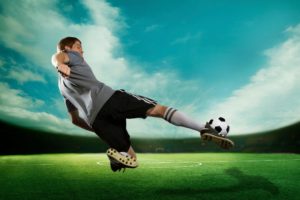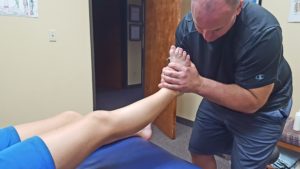 If you have ankle pain, then this article will help you understand what is wrong and what you can do to fix it. Though there are many ways you can injure your ankle, the most common injuries are:
If you have ankle pain, then this article will help you understand what is wrong and what you can do to fix it. Though there are many ways you can injure your ankle, the most common injuries are:
- Ankle Sprain
- Ankle Fracture
- Ankle Impingement
Ankle Sprain
 The most common injury to the ankle is a sprain. If you feel your ankle “roll over” causing intense ankle pain and almost immediate swelling on the outside of your ankle and foot, then you have a sprained ankle. Most often, when you turn your ankle, you only do damage to the soft tissue structures like the ligaments that stabilize the outside of your foot/ankle. Ankle sprains can lead to ankle impingement (see below).
The most common injury to the ankle is a sprain. If you feel your ankle “roll over” causing intense ankle pain and almost immediate swelling on the outside of your ankle and foot, then you have a sprained ankle. Most often, when you turn your ankle, you only do damage to the soft tissue structures like the ligaments that stabilize the outside of your foot/ankle. Ankle sprains can lead to ankle impingement (see below).
Note: you can sprain the ligaments on the inside of the ankle, but this is less common.
Treatment of an ankle sprain should include elevation of the leg, soft tissue therapy, compression bands/sleeves/splints and interferential therapy to reduce the pain and swelling. We DO NOT apply ice to ankle sprains (see article entitled Is the Use of Ice for Soft Tissue Injuries Actually a Bad Idea?). Joint mobillization/manipulation of the foot and ankle can help restore the normal range of motion of the joints as this often is an issue after ankle sprain. As soon as possible, exercises are added to restore normal motion of the ankle. Most ankle sprains can be back to normal in 1-3 weeks if treated properly.
Ankle Fracture
 Occasionally, what looks like an ankle sprain is actually a fracture of one of the bones in the ankle. If you hear/feel a crack when you injure your ankle and you cannot put weight on the injured foot, get x-rays to determine the extent of your injury. Ankle fractures will be treated by an orthopedic surgeon either by bracing, casting or stabilizing surgery depending on the extent of the injury.
Occasionally, what looks like an ankle sprain is actually a fracture of one of the bones in the ankle. If you hear/feel a crack when you injure your ankle and you cannot put weight on the injured foot, get x-rays to determine the extent of your injury. Ankle fractures will be treated by an orthopedic surgeon either by bracing, casting or stabilizing surgery depending on the extent of the injury.
Ankle Impingement
 Ankle impingement is commonly seen in athletes (especially soccer and dance), and can be divided into anterior and posterior impingement.
Ankle impingement is commonly seen in athletes (especially soccer and dance), and can be divided into anterior and posterior impingement.
Anterior impingement (footballers ankle) is caused by repeated dorsiflexion (movement of the foot upwards towards the shin) which can compress the soft tissue structures in the front of the ankle. Repetitive ankle sprains and a high-arched foot have been shown to be related to anterior impingement. As anterior impingement becomes chronic, additional symptoms may include instability, limited ankle motion, and pain with squatting, sprinting, stair climbing, and hill climbing.
Posterior impingement (dancer’s heel) is caused by repeated plantarflexion (movement of the foot downward) which can compress the soft tissue structures in the back of the ankle. The specific structures that can be compressed in posterior impingement are:
- flexor hallucis longus muscle
- posterior capsule
- os trigonum (most common)
How to Evaluate the Ankle
At Back to Function, we take a thorough history of how the injury happened, where the ankle pain is located and what positions, movements and activities make the ankle pain worse. Ankle sprains and fractures are usually obvious injuries to diagnose. Ankle impingement can be more difficult and a detailed posture and gait analysis can be extremely helpful in diagnosing an impingement. During the gait analysis, athletes with anterior ankle impingement who are typically missing dorsiflexion will shorten their step length, have an early heel rise, and reduce their knee flexion. It can also be compensated for more distally by increasing pronation in order to allow more dorsiflexion in the midfoot.
One of the best examination tests for anterior impingement is to force the athlete’s ankle into dorsiflexion and eversion. Pain in the front of the ankle during this test is indicative for anterior ankle impingement.
For posterior impingement, the athlete’s ankle is forced into plantarflexion. Pain in the back of the ankle during this test is indicative for posterior ankle impingement.
Treatment of ankle impingement includes rest from the inciting activity, interferential therapy, ankle stability exercises, soft tissue release of the ankle and lower leg muscles and fascia and chiropractic manipulation of the foot and ankle.

For anterior impingement, distraction adjusting of the talocrural joint is helpful.
For posterior impingement, distraction adjusting of the rearfoot is helpful.
If you have an ankle injury, please contact us at info@backtofunction.com or call 310-534-1900. Feel better and perform better today!
References
http://www.physio-pedia.com/Ankle_Impingement



